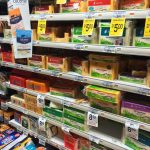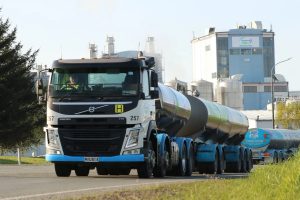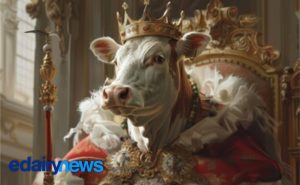
Jono and Kerri Robson are 50:50 sharemilkers on a 119-hectare farm at Waipukurau milking 350 cows.
From his experiences, Jono knew how unfavourable the traditional roster can be so when he and Kerri first started employing staff, they tried the 12-and-2 roster concept but found that to be undesirable as well.
Shifting to 6-and-2 was also challenging, making it hard to know who was meant to be where and when and they struggled to maintain their own life.
“I left school at 15 and grew up through the industry, which wasn’t easy or smooth sailing,” Jono explains.
“And after trying a few tactics as employers, we identified Kerri and I needed time during the week for things like meetings, farm maintenance and stuff with the kids.
“There are always things that pop up, so we need our weeks to be relatively flexible.”
They sat down with their team to discuss what could work and come with a solution that would work for everyone. As a team they decided that 5-and-2 could work well, especially as they all had children. So this season, they have had two full-time staff during the week, Tash and Toyah, who predominantly take care of the milkings, and Jono and their relief manager Kylie alternate weekend shifts.

This was their first season under the new roster and they have found it frees up Jono for other farm work and managing the support block.
“It has gone fabulously,” Kerri says.
“Our wage bill hasn’t been impacted much and the work we’re getting done outweighs it anyway.”
One of the girls had no background in dairying and started as a relief milker when the couple first moved to the Waipukurau farm. She then approached them about opportunities for more work.
“We keep our expectations clear, but there’s also flexibility if they need a mental health day or the kids are sick or something, they know they don’t have to be here,” Jono says.
“We find people do a better job to some extent if they’re running their own day.”
They are impressed with the enthusiasm of the team and it is clear how much they care about the business and animal health.
“The shed and calf-rearing gear have never been cleaner,” he says.
“I don’t think it’s just because it’s a team of girls, I think everyone is genuinely happy and enjoying the way we’re working.”
And with the weekly routine taken care of, Jono and Kerri are able to immerse themselves in their other commitments outside of the farm.
Jono holds a Diploma of Agriculture from Telford and keeps busy with his role in the Hawke’s Bay province for Federated Farmers as the sharemilker chairperson. He also gets involved with projects with the farm owner, Dean Nikora, who does consultancy across New Zealand.
Kerri is the Tararua regional leader for the Dairy Women’s Network and enjoys connecting with other farming women. She is also involved with the strategic thinking cohort at Food HQ and is heading to Costa Rica later this year, which she is very excited about.
She has a Bachelor in Business Studies and is working towards completing some post-graduate study in Agribusiness through Massey University. And she is the secretary and event secretary for the local pony club. They have two kids, Evie, seven, and Thomas, four, and they are both into motorbikes and ponies.

“My background is horses and Jono’s is motorbikes, so it’s a bit of a competition of which one is more favoured,” Kerri laughs.
Somehow among all of that, they also manage to participate in local discussion groups, vet demonstration days and the local careers day through Primary ITO.
“Having the flexibility with our team and managing the farm has really supported our off-farm commitments, we are definitely striking a better balance,” she says.
The couple met outside of the dairy sector. Jono had left a life in Southland and ventured to the North Island, taking a role in a joinery shop where Kerri was a kitchen designer.
“I grew up on a small sheep and beef block and during high school, I was involved in a course that needed some work experience,” Jono says.
“Dad wouldn’t let me do it at home, so I went down the road to the local dairy farm.
“And the work experience led to a relief milking job, but it wasn’t long till I left school to go full-time dairying.”
By the time he was 19 he owned 80 cows and he was in a variable order sharemilking role for two seasons before he chucked it all in to head north.

“I sold most of the cows and leased out the remainder,” he says.
“I didn’t know what I wanted to do but knew I needed to get away and try something different for a while, I was feeling burnt out, I had overexerted myself too young.”
Landing in the North Island was a fresh start, but farming stayed in the back of his mind. And after a few years he managed to convince Kerri they should get into it together.
“I came from an orchard, so I didn’t know anything about dairying,” Kerri says.
“But Jono had talked about the good parts and we’d decided that we wanted to bring up our family on a farm.”
She did not imagine moving to the back blocks of Patoka though.
“I used to do a lot of hunting in the Kaweka Ranges and when I was driving up one morning I noticed all the dairy shed lights on at four in the morning,” Jono says.
“There are only about 13 farms in Patoka, so I drove back up one Friday and spent the day dropping my CV around the farms and having a yarn.”
One of the farms stood out to him and they had an entry-level role going, so they rented out the house Kerri owned in Napier and moved to the back blocks. It was a foot in the door, but it was only six months till Jono took over running the farm. And after four seasons the couple became contract milkers, milking 750 cows once-a-day through a 60-bail rotary.
“Once-a-day suited the farm, there were long walks and steep terrain so we recognised once-a-day was the best way for the staff and animals,” he says.
But they started longing for simplicity and began looking at their options. It was their bank manager that connected them with the owners of their current farm in Waipukurau, owned by Dean Nikora and Alexandra Stewart.
They secured a 30% variable order sharemilking role and moved from being a 45-minute drive to the nearest dairy to having fish and chips on their doorstep. It was a game-changer for the family, especially with their involvement in the community.
One of the team members they had in Patoka moved down with them too and only left at the end of last season.
“We’ve been pretty lucky with staff, which helps a lot with balancing our lives on and off the farm,” he says.
The farm is 119 hectares, with a 26-a-side herringbone shed. The farm is irrigated, which supports their pasture growth significantly and helps them maintain a System 3, with limited feed being bought in.
After two seasons of contact milking, they bought the herd to go 50:50 sharemilking this season.
“We had come to the farm with our goal of buying a herd within two years,” Kerri says,
“We sold the house in Napier to build our deposit and Dean and Alexandra were keen to buy the neighbouring piggery so wanted to free up some equity, the timing was great.”
They worked with StockCo to secure enough funding to purchase the herd, which was a straightforward process.

“We were fortunate StockCo appreciated the true value of our herd and enabled us to achieve our goal of being 50:50 sharemilkers this season,” they say.
“Their experienced staff understood dairy scenarios and had many options available to suit any needs and situation.
“We found them to be incredibly flexible and it was great they were locally based.”
They bought the herd of 350 KiwiCross cows, as well as the youngstock, but they are planning to reduce cow numbers next season.
“Our most efficient production was when we were stocked at 2.8 cows to the hectare,” Jono says.
“In our first season we produced 460 kilograms of milksolids per cow and we were milking 330 cows, but last season we only achieved 435 with 350 cows.
“It’s more sustainable at 2.8 cows.”
The target for this season was 157,500kg MS, but they think they will fall slightly short. Largely due to the weather, because even though there was good rain in December it changed quickly to very dry in January. And then they got 150mm of rain in a week.
But on top of managing the grass at home, they have been leasing the neighbouring farm. They locked up some paddocks for silage, but struggled to get it harvested because of the weather and contractor availability.
They ended up deferred grazing it with the youngstock, but it also did not perform the way they had expected. And the delays with getting culls into the works kept the pressure on the feed situation.
“It’s been one of those seasons where everything you don’t want to happen, has happened,” Jono says.
“It has been a challenging year and with how fast we grew we haven’t had time to get grounded, we’ve basically been farming by the seat of our pants.”

They have developed solid plans going forward, with extensive regrassing with annual and permanent pastures, as well as turnips on the support block to winter the herd and support the youngstock through spring. And they are anticipating a reasonable surplus, which will make more baleage that will hopefully be more desirable to a contractor to cut.
“Come summer we’ll have a bigger bank of feed in case we come into strife again,” he says.
“We’re pretty comfortable we’ve got this season’s problems sorted (and) ready for next season, but thankfully the record payout has been a saving grace.
“It was a great time to go sharemilking.”
In a typical season they operate a System 3, with cows coming onto the feedpad for maize and palm kernel through calving. Freshly calved cows are drafted each day and if the conditions are right they go straight onto pasture only through spring. They utilise the spring rotation planner to keep on top of it all and the irrigation comes on in late November.
When growth rates start exceeding 50kg/DM/day they try to extend their rotation. Once they are through December they generally feed more palm kernel to keep a handbrake on the rotation. But they also have baleage on hand and utilise nitrogen strategically.
And by autumn they have maize ready to go.
“We use an early maturing maize so this season it was ready by March 5, which is really early, and we got about 135 tonnes,” he says.
“We feed it through autumn to put weight on the cows and extend our rotation past 45 days and we dry-off according to body condition scores, to make sure they’re ready for calving.”
Through winter, 230 of the herd will be wintered on the support block eating straw, oats and an annual pasture, Winter Star. The rising one-year-olds will also be on the block grazing permanent pasture. And the first calvers are in great condition and will be wintered on the dairy platform alongside the early calving cows on a 120-day round.

They are conscious of starting magnesium supplementation in time for calving to help minimise milk fever. Having the cows on the platform allows them to dust paddocks ahead of grazing.
“We use pig and dairy effluent over the whole farm as a combined fertiliser to bring down the cost of synthetic fertilisers,” he says.
“But this brings our potassium levels up, which could increase our risk of milk fever, so pre-calving magnesium supplementation is really important.”
They can come under pressure from down cows if there is a bout of bad weather that restricts their ability to dust, but they keep in good communication with their vets and keep an eye on as much as they can.
“We don’t have a problem as such, but it is something to be aware of and iron out,” he says.
Calving hits thick and fast; they maintain an 80% six-week in-calf rate so the bulk of their replacement calves come in the first three weeks. It makes rearing busy, but keeps things simple and traditionally Kerri has done most of it on her own.
They usually rear around 84 replacements and last season they tried rearing more with 40 Angus calves.
They follow all the best practice recommendations, using the Brix refractometer to test their colostrum and blood test to make sure the calves are getting their passive transfer. And it has been paying off, with a zero percent mortality rate among the calves since they have been on the farm.
“The calf-rearing does happen in a whirlwind,” Kerri says.
“Since they all come in so fast they are all pretty similar sizes and we aim to have them out on grass as soon as possible.

“We keep them on milk till they’re about 85 kilograms and they stay on pellets until the mob average is over 100 kilograms, which is usually around mid-November then they all go to the support block.”
While the calves are on the farm they rotate behind the cows, usually moving once or twice-a-week.
Knowing calving will be more hectic this coming season, they are already looking at their options for selling calves to make sure the beef calves will be out of the sheds as soon as possible. The aim will be to have them gone between four days and two weeks old with roughly 20 staying behind to sell at the weaner sales in late spring.
“That will depend on how busy we are, if it’s all getting too full on we won’t keep any around if we can help it,” she says.
“The team are keen to help out in the calf sheds too, so it will probably be a rotation between the three of us just to have a few more hands on deck.”
Mating lasts nine weeks. but next season they plan to reduce it to eight. The herd is DNA tested so they are safeguarded from accidentally keeping a beef calf as a replacement.
This season, in an attempt to reduce bobby calves, they have used beef bulls strategically across the herd and they expect to have a lot more calves coming through the shed.
“We’ve been using white face semen to mark the end of artificial insemination, but we always seem to struggle to sell them, the market isn’t there for the patchy white face,” Jono says.
“So this year we have used Speckle Park semen across the herd, we figured we would go full patchy and hope there is a market for them.”
This was their first season not using a ‘why wait’ programme and they were pleased they maintained their great reproductive performance results. They utilised sexed semen across the better cows and everything else went to beef. After five weeks of artificial insemination and the white face marker, they tailed with low birthweight Angus bulls. The heifers were also naturally mated to low birthweight Angus bulls.
“We tried low birthweight Angus in some of the herd last season and all of them calved without any assistance, we’re pretty confident it will go well,” he says.
“We’ve got pretty small efficient cows and that was our test, we were pleased with the results.
“Our stock agent connected us with a pretty reputable breeder and we used yearling bulls for the heifers.”
Their next goal after herd ownership was to win the Share Farmer of the Year category at the New Zealand Dairy Industry Awards, which they did last month at the Hawke’s Bay/Wairarapa Awards.
They have entered the Share Farmer category twice previously, while Jono is also a past entrant in the Dairy Manager category.
“We were over the moon, we had entered before and we get so much out of it every time,” Kerri says.
“The awards helped us recognise the purpose and direction that was best for our business and the feedback provided by the judges has been invaluable.”
“We enjoy the relationships and other networking avenues that the awards have opened up for us and find it inspiring to meet industry powerhouses at the Awards dinners.”
Their sights are now set on the next steps in their business and personal development. Their biggest short term goal is to have the herd paid off within four years. And they plan to buy their own dry stock farm within six years.
“We reckon we will be able to buy a farm by 2028 and that will allow us to keep the beef calves we’re rearing for longer, to add some diversity to the business,” she says.
They are keen to find a lease block to rear the beef calves in the meantime. And they would also like to buy a house.
On a personal level, Jono is keen to take part in the Kellogg Rural Leadership Programme and the Fonterra Governance Development Programme in the near future. And despite the rocky start to his dairying career, he is pleased he made it back to the industry and that Kerri has joined him for the ride.

























